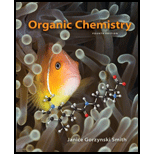
Concept explainers
(a)
Interpretation: The name of the given
Concept introduction:
1. The hydrocarbon is named after the longest carbon chain.
2. The parent hydrocarbon containing amino group is named as
3. When the nitrogen atom of amine is substituted with alkyl groups, then the amine is named with prefix
(b)
Interpretation: The name of the given amine is to be determined.
Concept introduction: IUPAC nomenclature is a systematic way of naming the organic compounds. The basic principles of IUPAC naming for hydrocarbon are:
1. The hydrocarbon is named after the longest carbon chain.
2. The parent hydrocarbon containing amino group is named as alkane with suffix amine.
3. When the nitrogen atom of amine is substituted with alkyl groups, then the amine is named with prefix
(c)
Interpretation: The name of the given amine is to be determined.
Concept introduction: IUPAC nomenclature is a systematic way of naming the organic compounds. The basic principles of IUPAC naming for hydrocarbon are:
1. The hydrocarbon is named after the longest carbon chain.
2. The parent hydrocarbon containing amino group is named as alkane with suffix amine.
3. When the nitrogen atom of amine is substituted with alkyl groups, then the amine is named with prefix
(d)
Interpretation: The name of the given amine is to be determined.
Concept introduction: IUPAC nomenclature is a systematic way of naming the organic compounds. The basic principles of IUPAC naming for hydrocarbon are:
1. The hydrocarbon is named after the longest carbon chain.
2. The parent hydrocarbon containing amino group is named as alkane with suffix amine.
3. When the nitrogen atom of amine is substituted with alkyl groups, then the amine is named with prefix
(e)
Interpretation: The name of the given amine is to be determined.
Concept introduction: IUPAC nomenclature is a systematic way of naming the organic compounds. The basic principles of IUPAC naming for hydrocarbon are:
1. The hydrocarbon is named after the longest carbon chain.
2. The parent hydrocarbon containing amino group is named as alkane with suffix amine.
3. When the nitrogen atom of amine is substituted with alkyl groups, then the amine is named with prefix
(f)
Interpretation: The name of the given amine is to be determined.
Concept introduction: IUPAC nomenclature is a systematic way of naming the organic compounds. The basic principles of IUPAC naming for hydrocarbon are:
1. The hydrocarbon is named after the longest carbon chain.
1. The parent hydrocarbon containing amino group is named as alkane with suffix amine.
2. When the nitrogen atom of amine is substituted with alkyl groups, then the amine is named with prefix
Want to see the full answer?
Check out a sample textbook solution
Chapter 25 Solutions
Organic Chemistry-Package(Custom)
- What is the product of the reaction? F3C. CF3 OMe NaOH / H₂Oarrow_forwardWhat would you expect to be the major product obtained from the following reaction? Please explain what is happening here. Provide a detailed explanation and a drawing showing how the reaction occurs. The correct answer to this question is V.arrow_forwardPlease answer the question for the reactions, thank youarrow_forward
- What is the product of the following reaction? Please include a detailed explanation of what is happening in this question. Include a drawing showing how the reagent is reacting with the catalyst to produce the correct product. The correct answer is IV.arrow_forwardPlease complete the reactions, thank youarrow_forwardConsider the synthesis. What is compound Y? Please explain what is happening in this question. Provide a detailed explanation and a drawing to show how the compound Y creates the product. The correct answer is D.arrow_forward
- What would be the major product of the following reaction? Please include a detailed explanation of what is happening in this question. Include steps and a drawing to show this reaction proceeds and how the final product is formed. The correct answer is B. I put answer D and I don't really understand what is going on in the question.arrow_forwardWhat is the product of the following reaction? Please explain what is happening in this question. Provide a detailed explanation and a drawing showing how the reagent is reacting with the catalysts to product the correct product. The correct answer is B.arrow_forwardWhat is the missing intermediate 1 and the final product 2. Please include a detailed explanation explaining the steps of malonic ester synthesis. Please include drawings of the intermediate and how it occurs and how the final product is former.arrow_forward
 Introductory Chemistry: An Active Learning Approa...ChemistryISBN:9781305079250Author:Mark S. Cracolice, Ed PetersPublisher:Cengage Learning
Introductory Chemistry: An Active Learning Approa...ChemistryISBN:9781305079250Author:Mark S. Cracolice, Ed PetersPublisher:Cengage Learning Organic Chemistry: A Guided InquiryChemistryISBN:9780618974122Author:Andrei StraumanisPublisher:Cengage Learning
Organic Chemistry: A Guided InquiryChemistryISBN:9780618974122Author:Andrei StraumanisPublisher:Cengage Learning
- Chemistry: Matter and ChangeChemistryISBN:9780078746376Author:Dinah Zike, Laurel Dingrando, Nicholas Hainen, Cheryl WistromPublisher:Glencoe/McGraw-Hill School Pub Co
 Chemistry for Today: General, Organic, and Bioche...ChemistryISBN:9781305960060Author:Spencer L. Seager, Michael R. Slabaugh, Maren S. HansenPublisher:Cengage Learning
Chemistry for Today: General, Organic, and Bioche...ChemistryISBN:9781305960060Author:Spencer L. Seager, Michael R. Slabaugh, Maren S. HansenPublisher:Cengage Learning





